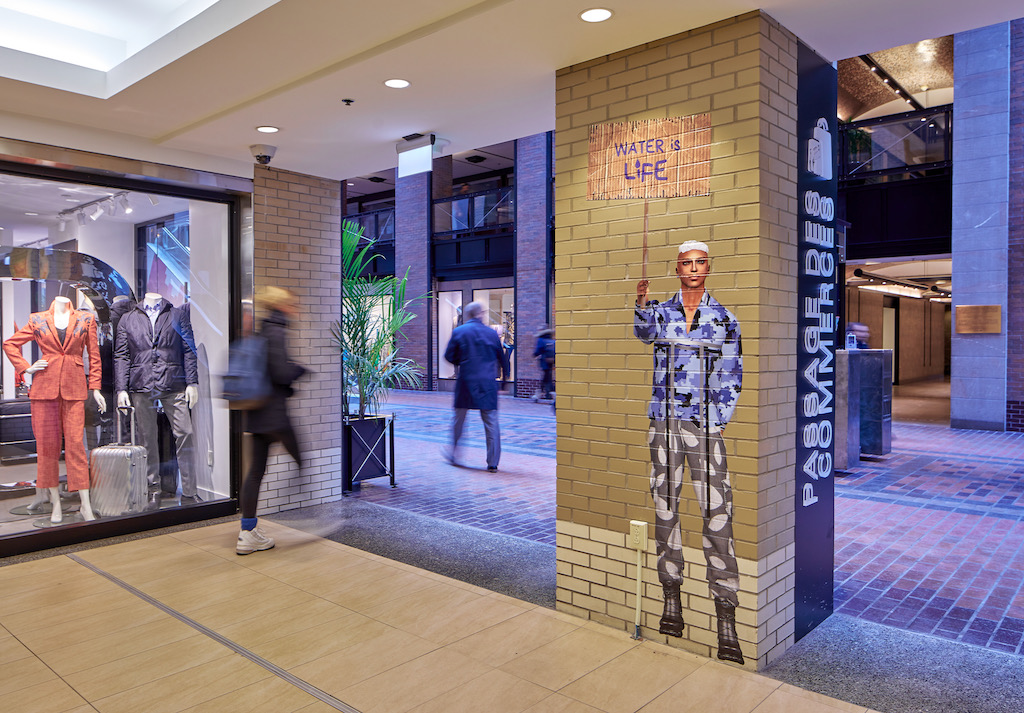If you could start from nothing how would you imagine the world? ” Humanity is at a turning point. Should we persist in our habits or become aware of our repetitive way of life in order to rebuild from the ground up? “
Following a first collaboration with Art Souterrain, its artistic director, Frédéric Loury, invited me to act as curator for the 2020 edition of the festival under the theme of “RESET”. I had already explored the imaginaries of historical construction at the International Contemporary Art Symposium in Baie-Saint-Paul, whose theme Presence of the Past. Inventing the future led the 2017 edition.
As part of RESET, I took pleasure in developing new collaborations with artists I had known in this context: Caroline Monnet, Sarah Wendt + Pascal Dufaux and the Cabinet de Fumisterie appliqué (CFA). I also took the opportunity to continue this reflection around collaborations with artists whose work I had followed for a while: arkadi Lavoie-Lachapelle, Bonnie Baxter, Daniel Corbeil, Dominique Sirois, Skawennati and I renewed my approach to work by JJ Levine, which I presented during Vitrine sur l’art in 2018 around gender issues.
The artists gathered here imagine the present and the future from new perspectives, which also invite you to dream of the future. Their work was presented at the Guy-Favreau Complex (Daniel Corbeil), at the Palais des congrès de Montréal (arkadi lavoie-lachapelle), at the World Trade Center (JJ Levine and Skawennati), at Place Victoria (Sarah Wendt + Pascal Dufaux and the Cabinet de Fumisterie Appliquée (Elsa Ferry and Anastasia Bolchakova), at the Cité internationale (Caroline Monnet and Dominique Sirois) and in a satellite location at the Place-Ville-Marie Observatory (Bonnie Baxter).
Marie Perrault, guest curator
Daniel Corbeil
Lives and works in Montréal
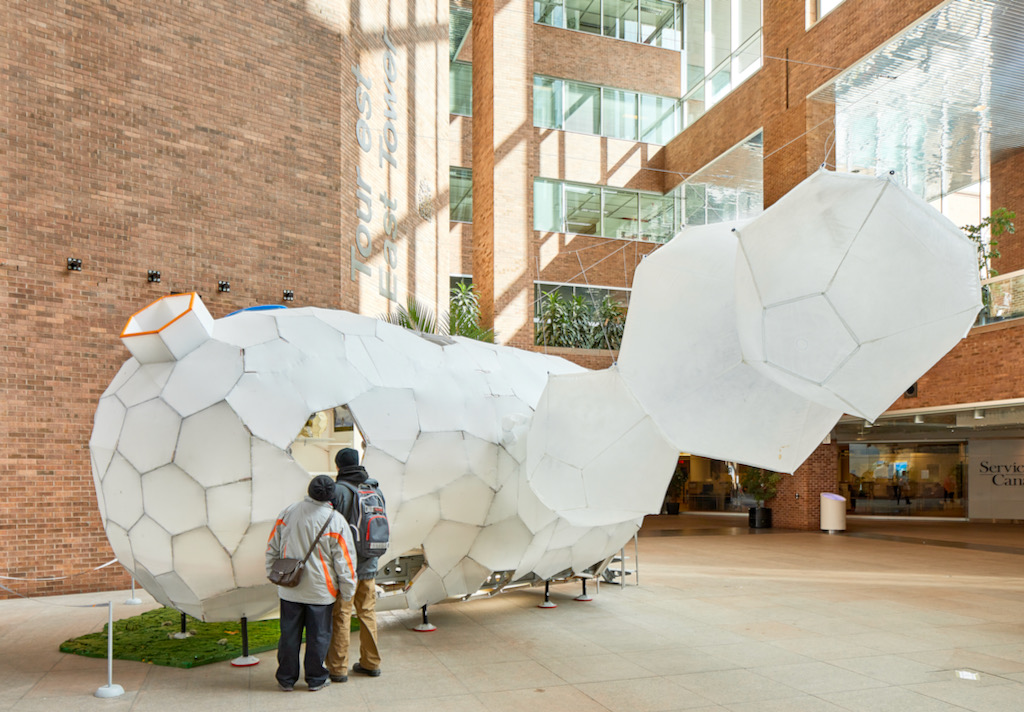
Module de survie is an architectural installation offering the visitor an opportunity to discover the potential form an ecological zoomorphic modular habitat could take, which would allow each person to live autonomously in a future where food and energy resources are limited. In the spirit of the earthship concept (based on the ideas of recycling and self-sufficiency), this module is a projection, imagined by Corbeil as a sculptor, of a home that can produce the food, filtered water and gas needed for domestic use
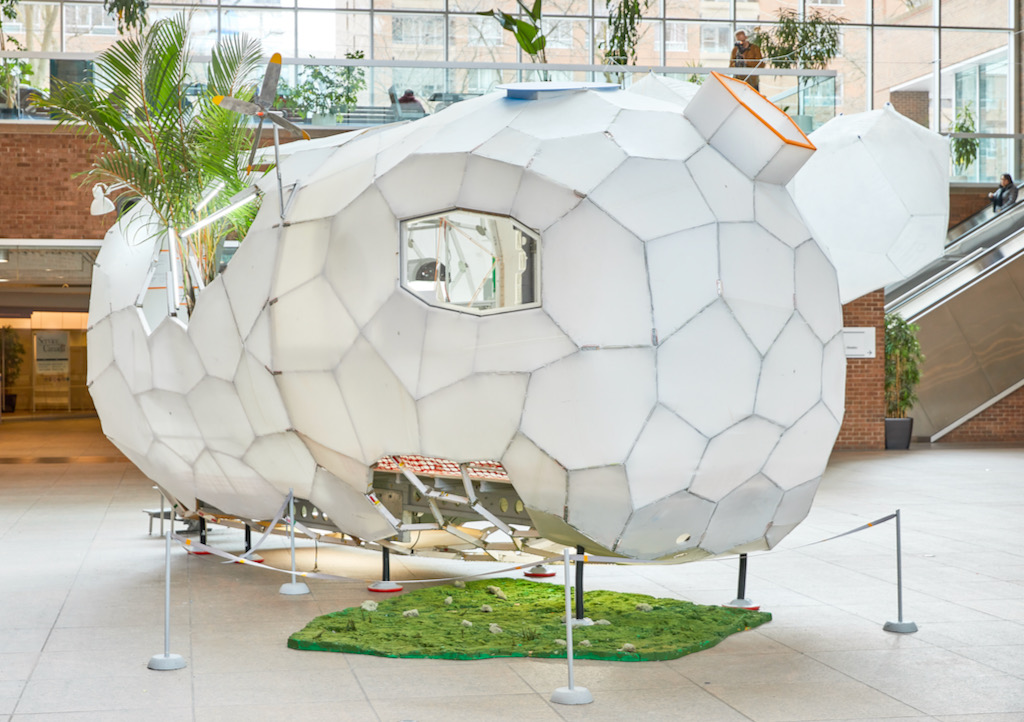
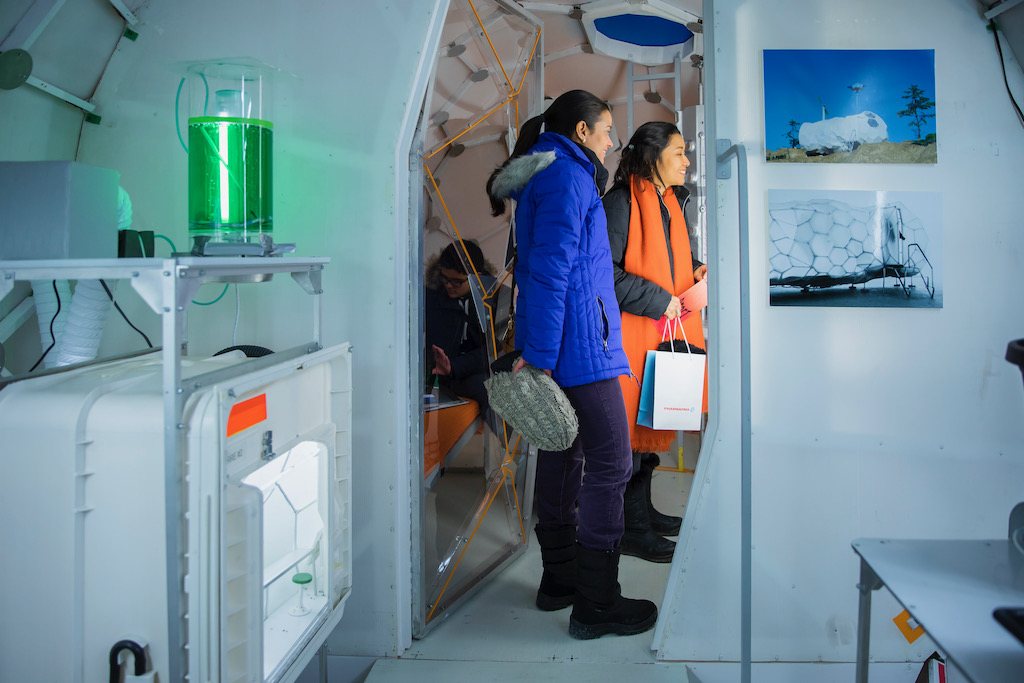
The installation simulates a “technologically green” habitat as an eggshaped greenhouse using translucent hexagonal panels in which living and food production areas are combined. Concerned for a number of years by the rapid rate of change imposed on nature by human actions, Daniel Corbeil has sought to tes- tify as to its impact through the prism of the environmental sciences and through the use of green technologies in architecture. The viewer alone must determine if the artist’s playful ecofiction is utopian or dystopian.

Having grown up in Abitibi, Daniel Corbeil lives and works in Montreal. He has a Bachelor of Fine Arts degree from the Université du Québec en Abitibi-Témiscamingue as well as a Master of Fine Arts degree from the Université du Québec à Montréal. He has been teaching visual arts at the Cégep du Vieux-Montréal since 1999. His work has been regularly shown across Quebec, Can- ada and internationally. His pieces are collected by both public institutions and private individuals. Daniel Corbeil has also realized several public artworks.
arkadi lavoie-lachapelle
Lives and works in Montréal
This moveable and collapsible piece of artisanal fur-niture was created by arkadi lavoie lachapelle in collaboration with the cabinet-maker Gilles Rivard. Since 2012, it has been shown in different locations.This artwork aims to create a shareable space where individuals can come together, building a future based on common fellowship. In October 2015, as part of a project with Verticale – centre d’artistes, the piece was assembled in Mont-de-La Salle’s main hallway (a secondary school in Laval) for the entire school year. Students, staff members, parents and visitors made this singular bench their own, rocking together as they would chit-chat or simply sit down a moment to relax.
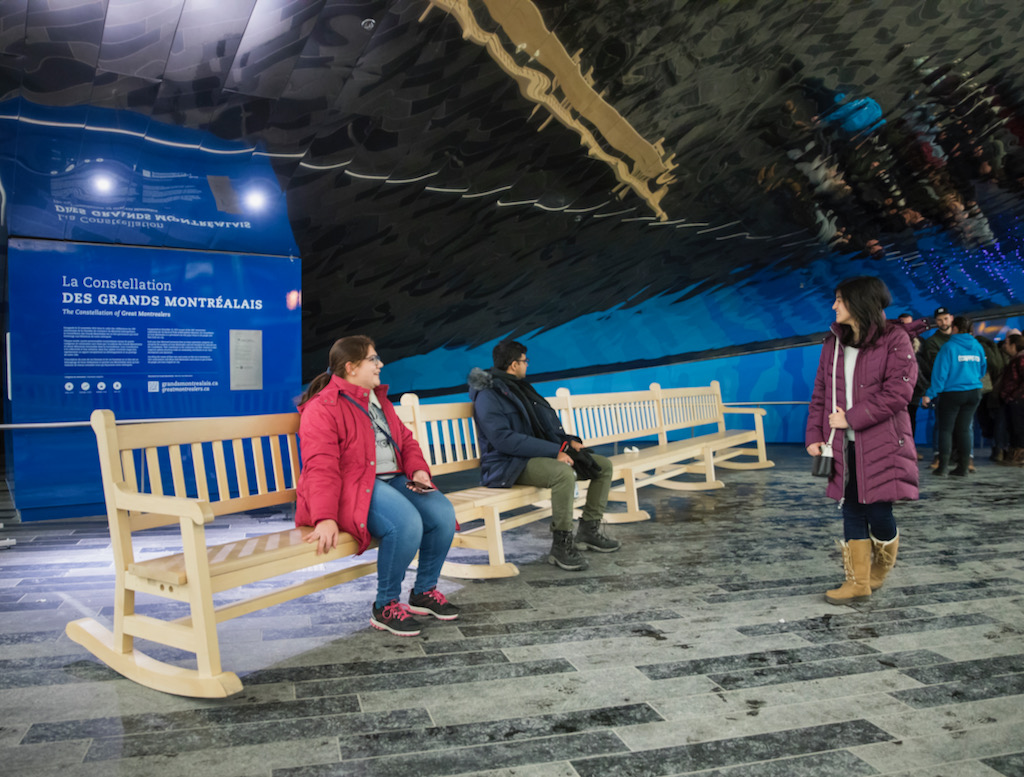
In the fall of 2016, the school’s student democratic body, the Parlement du Mont, passed a resolution in favour of acquiring a more solid model of the bench. This motion from the students was en- dorsed by the school’s governing board. Since then, a crowdfunding campaign (http://www.gofundme. com/lachoraleaumont) has been organized in support of the students’ efforts to purchase the bench. Its presence here is an invitation to share in these students’ sense of community. Since then, enough money was raised for the reconstruction of La Chorale 2 to go forward in 2020-2021, so it can be permanently installed into the Mont-de-La-Salle secondary school, as the students wanted.
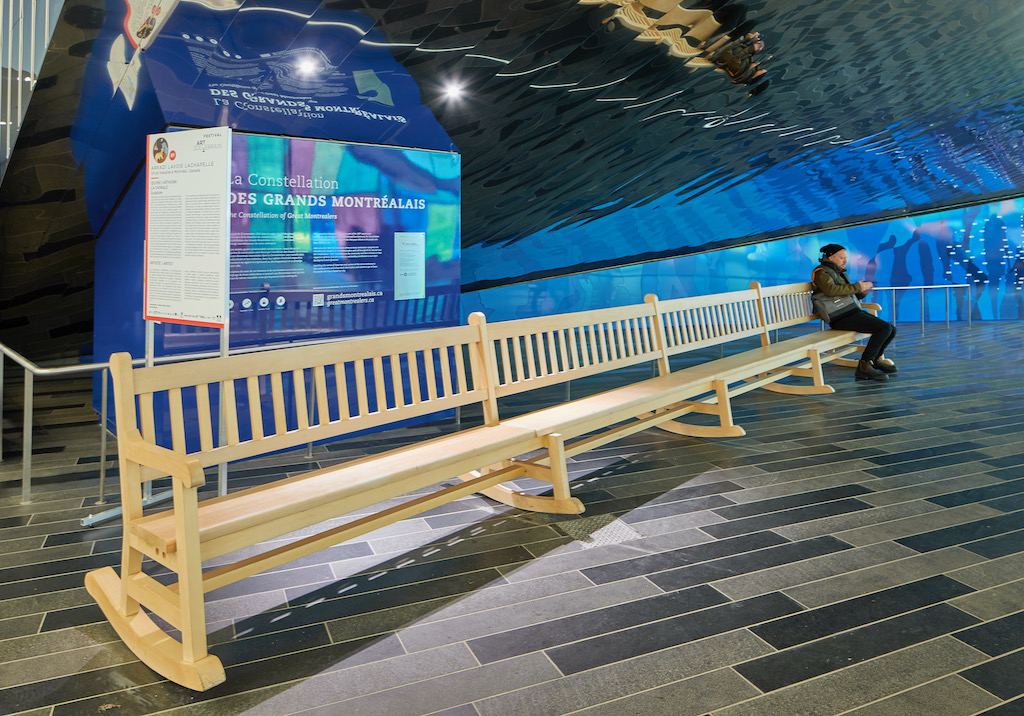
Using clandestine actions, pop-up performances in public spaces or gallery installations, arkadi lavoie lachapelle creates situations that bring into question today’s prevailing productivity-centred ideology, countering it up to a point by fostering a festive and celebratory atmosphere. Born the year of the fall of the Berlin Wall fell and of the Polytechnique shootings, raised in a middle-class family settled in Lanaudière, arkadi lavoie lachapelle lives and works in Montreal. She participates in the organization of events such as VIVA! Art.
JJ Levine
Lives and works in Montréal
In this selection of photos and videos, JJ Levine examines how his family and friends who identify as members of the LGBTQ+ community experience friendship, living as a couple and family life. For these people, the privacy of the home is where they can freely express their choices regarding gender and sexuality, choices that are regularly marginalized.

Using professional cameras and lighting equipment, JJ Levine recreates a photography studio within the privacy of their domestic environment. Half- way between staged scene and archive, these portraits reveal real people embodying their own roles in intimate places and times where each reinvents what it means to be a parent. Shown in a public space, JJ Levine’s works offer an alternative to representations of the heteronormative configuration of the family. They shed light on queer and trans family structures that are rarely portrayed in this context or in the media to celebrate both how ordinary and remarkable this reality in fact is.
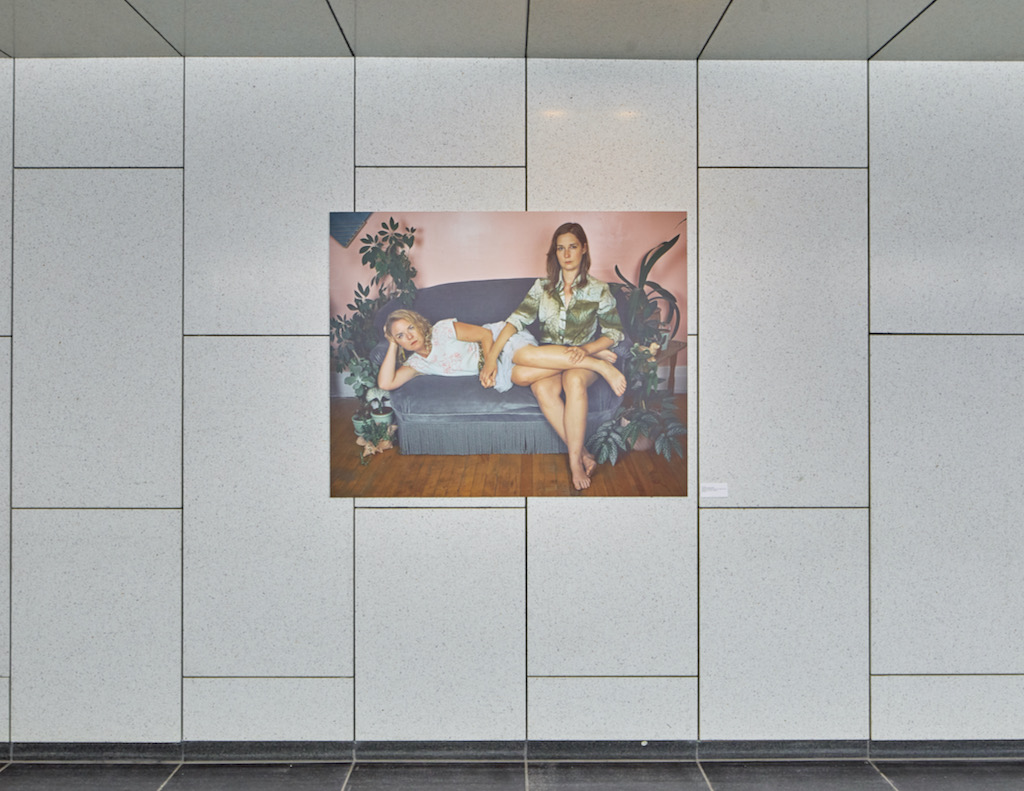
JJ Levine is an artist who lives and works in Montreal. His practice is centred around the LGBTQ+ community’s political demands. He is known for the Queer Portraits, Alone Time and Switch se- ries exhibited in the United States and Europe, likewise published in magazines, newspapers and artist books. His work has been awarded sever- al prizes and grants from the Conseil des arts et des lettres du Québec and the Canada Coun- cil for the Arts. He was shortlisted for the 2019 Prix découverte Louis Roederer presented by the Rencontres de la photographie d’Arles.
Skawennati
Lives and works in Montréal
Skawennati’s installation consists of activist avatars assembling throughout the space of the Centre de commerce mondial, with oversized textile patterns wrapping various architectural features. Called to action by the passé portrayals of Indigenous peoples as well as their almost total absence from futurist narratives, Skawennati imagines cyberpunk avatars that burst onto the scene and demand a thriving future for their communities here and now.

By reinterpreting camouflage patterns, often worn by Indigenous people on reservations or during demonstrations, and the calico motifs of the ribbon shirts worn as regalia, the artist is literally occupying the shopping arcade of the Centre de commerce mondial. A conveyer of identity, these patterns are reminders of the resistance of First Nations to assimilation.
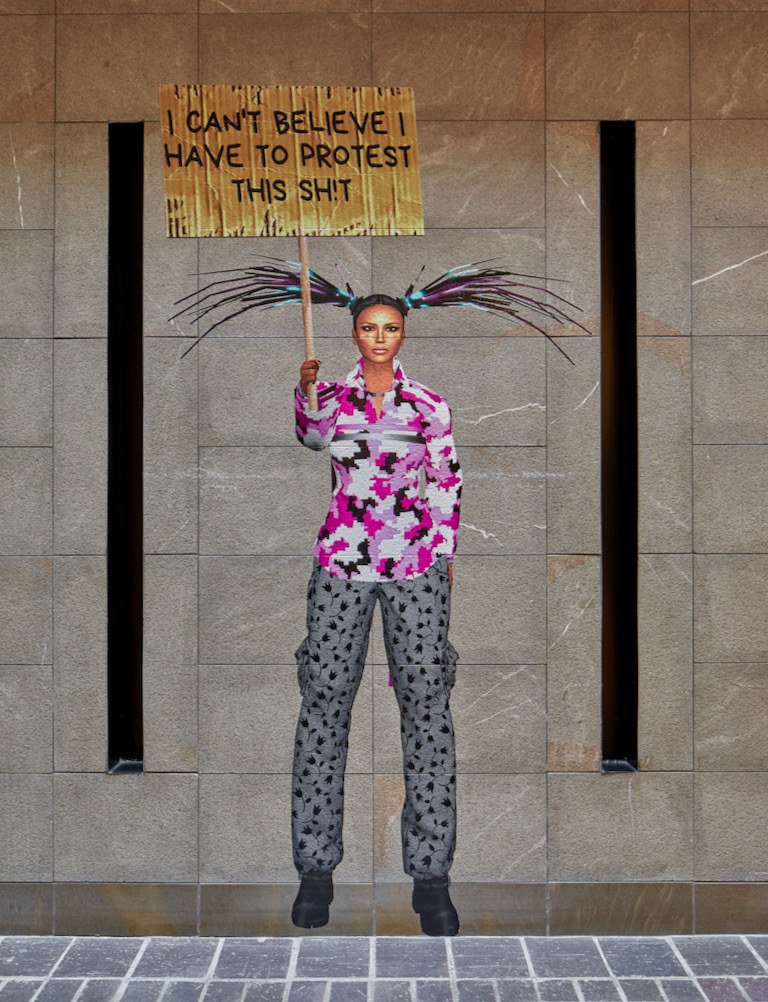
The clothing worn by the avatars will become Skawennati first fashion collection, and are also a manner of counteracting the fast fashions being sold in nearby stores. She breaks with the sometimes nostalgic or folkloric representations of Indigenous people to fully bring them into the 21st century as agents of contemporary shifts and trends. Indigenous artists such as Katsi’tsakwas Ellen Gabriel have connected camouflage, activism and the Indigenous body to make fashion statements.Through this polymorphous presentation, Skawennati creates an art which takes on history and imagines these communities’ future.

Born in Kahnawà:ke Mohawk Territory, Skawennati is a member of the turtle clan. Her work, which has been widely shown in Canada and internationally, is collected by both private individuals and public institutions. She co-directs, along with Jason Edward Lewis, the AbTeC (Aboriginal Territories in Cyberspace), a research-creation network of artists and academics who study and develop Indigenous visual environments.
In 2015, she and Lewis also launched the Initiative for Indigenous Futures (IIF) dedicated to developing visions of Indigenous peoples tomorrow. Skawennati lives and works in Montreal. She is represented by ELLEPHANT.
Sarah Wendt + Pascal Dufaux
Live and work in Montréal
Sarah Wendt + Pascal Dufaux have collaboratively developed a conceptual and material process that is constantly being reinvented. Their individual approaches coalesce to create an intuitive and emotional art piece that evokes the counterpoint, a musical term designating the melodic interaction of two conversing phrases resulting in the creation a new melody of which the sum is greater than the parts. Within Wendt and Dufaux’s practice, this principle acts like an open play framework that allows for the free exploration of the creative process behind sculpture and performance art.
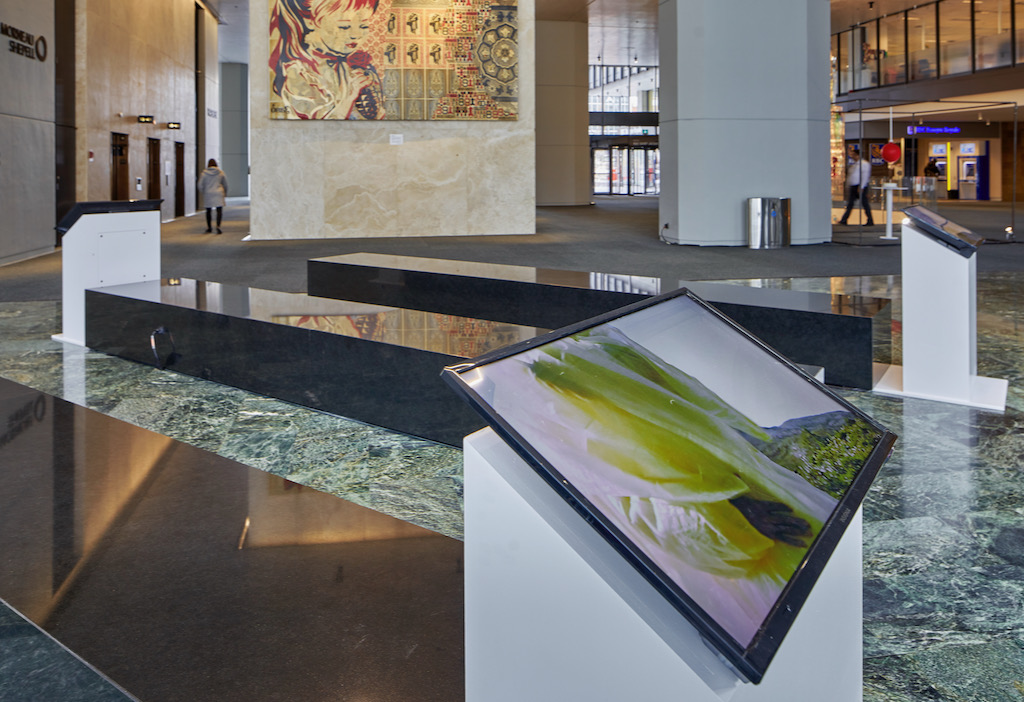
Wanting to contribute to the re-enchantment of the world, their pieces express as much their own ruin, including that of the materials, objects and scenery used, as they hint at possible futures. Shared post-human experiences are questioned through (inter) actions with polymorphous objects whose sensory qualities captivate the spectator. Both utopian and survivor, the spectator participates in a colourful staging of sculptural and pictorial objects that act like so many recollections of moments in time.
Born in Charlottetown, Prince Edward Islands, Sarah Wendt is based in Montreal. She studied contemporary dance at MainDance in Vancouver and the French horn at the University of Victoria. Originally from Marseille, Pascal Dufaux lives in Montreal where he studied stage design and fine art at Concordia University. Each has shown their work in Canada, Mexico, Europe and Australia. They have been working together since 2015, creating pieces that combine choreography, performance and installation art, which have been presented at the Symposium international d’art contemporain de Baie-Saint-Paul, Mois Multi, OFFTA and Axe Néo7 in Gatineau.
Le Cabinet de Fumisterie Appliquée (CFA) (Elsa Ferry et Anastasia Bolchakova)
Live and work in Paris, France
Horizon 2050 – Le Banquet is a segment of a multifaceted artistic project presenting an image of the future through the prism of the dietary practices of the second half of the 21 st century. The whole is based on Jean-Roger Helmin’s work Nutrition in 2050, edited by the artists, a compilation of scientific hypotheses and data as well as prankish futurist speculations.
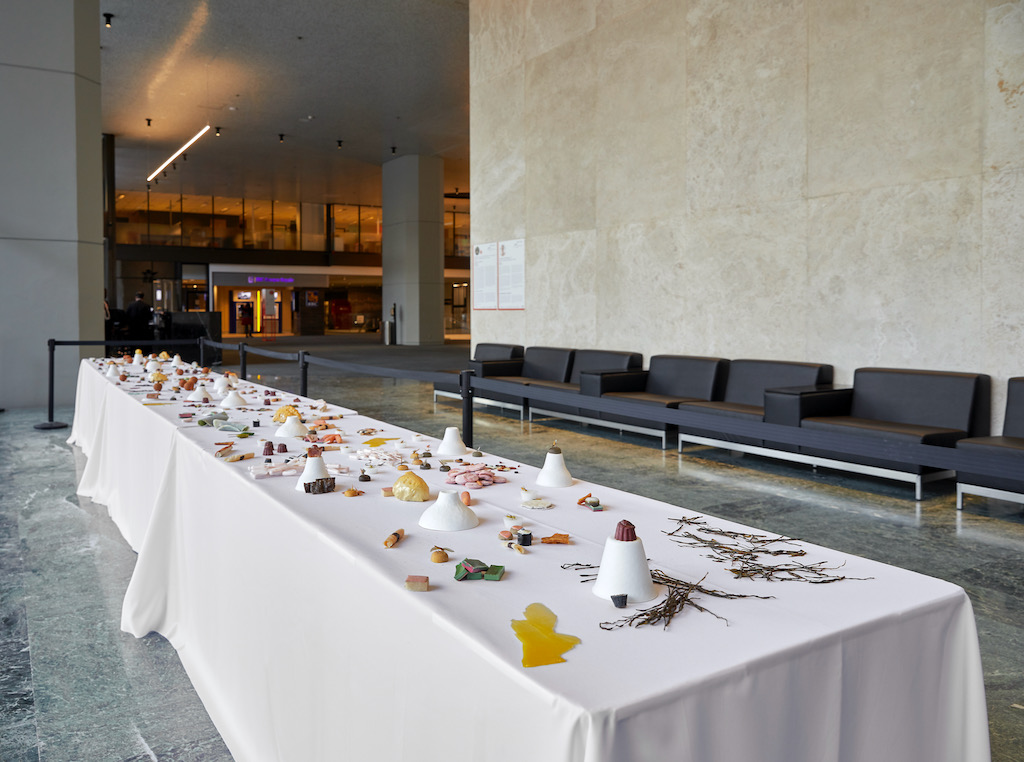
Attesting of a severe reduction in access to food, Horizon 2050 takes the form of a BIG BANG SELF and Govern- mental Food Distribution Units (UDAG) as well as the laboratories of the International Commission to a star-studded market at the command of the elite (CICE). Intended for these privileged few, Banquet showcases the consumption of insects or worms, a revival of ancestral practices, and of synthetic lab-made foods. In a context of a global governing system in the grips of exponentially growing economic disparity, it equally testifies to a preferential access to a range of more diverse, healthier and sophisticated resources than what most of the population can obtain.
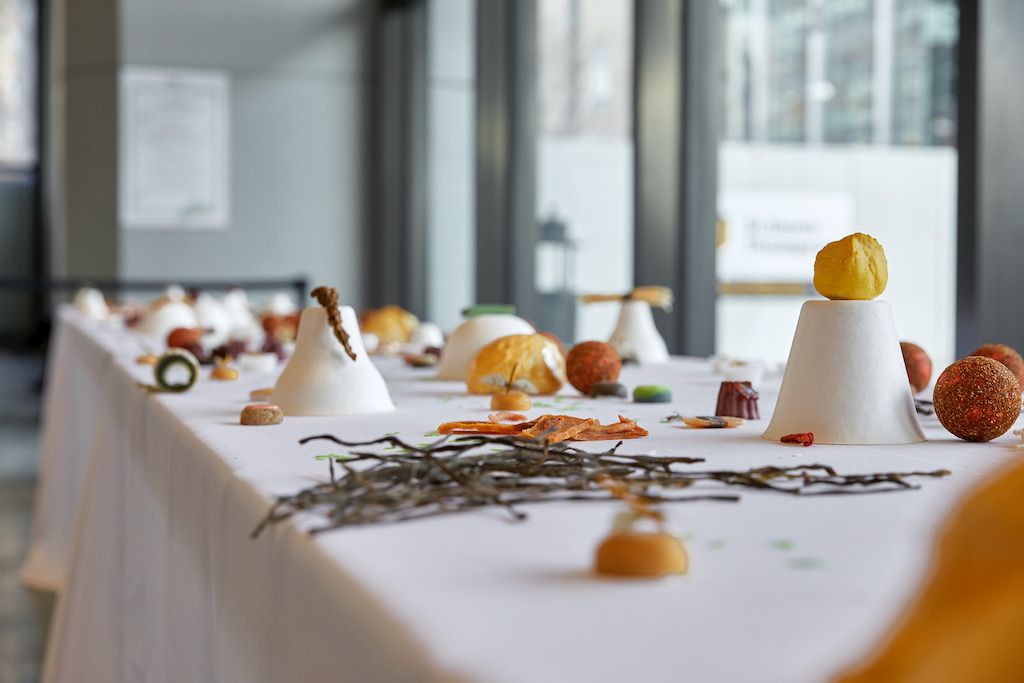
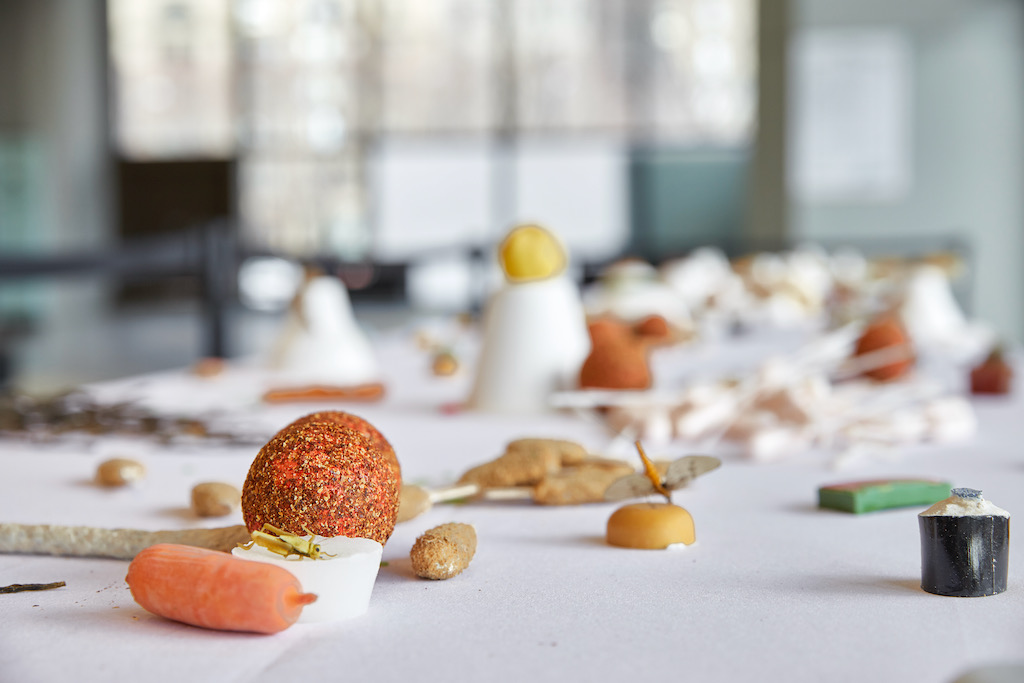
The Cabinet de Fumisterie Appliquée (CFA) is the duo Elsa Ferry and the Russian-born artist Anastasia Bolchakova, both based in France. Together they tackle issues relating to our future through scientific speculations and disaster scenarios inspired by headlines. Their projects, present- ed in France, Europe and Quebec, notably the Nutrition in 2050 and Horizon 2050 edition, from which Le Banquet is taken, explore a foreseeable future’s plastic, tragicomic and anxiety-provoking potential.
Caroline Monnet
Lives and works in Montréal
In the Name of Progress is inspired by traditional Anishinabe motifs that have passed on generation to generation through the maternal line. The artist here underscores the ancestral legacy of this visual vocabulary. At the same time, she pays tribute to Indigenous culture and its perseverance in the face of adversity. The idea of progress is made manifest by the methods Monnet used to produce the original works.
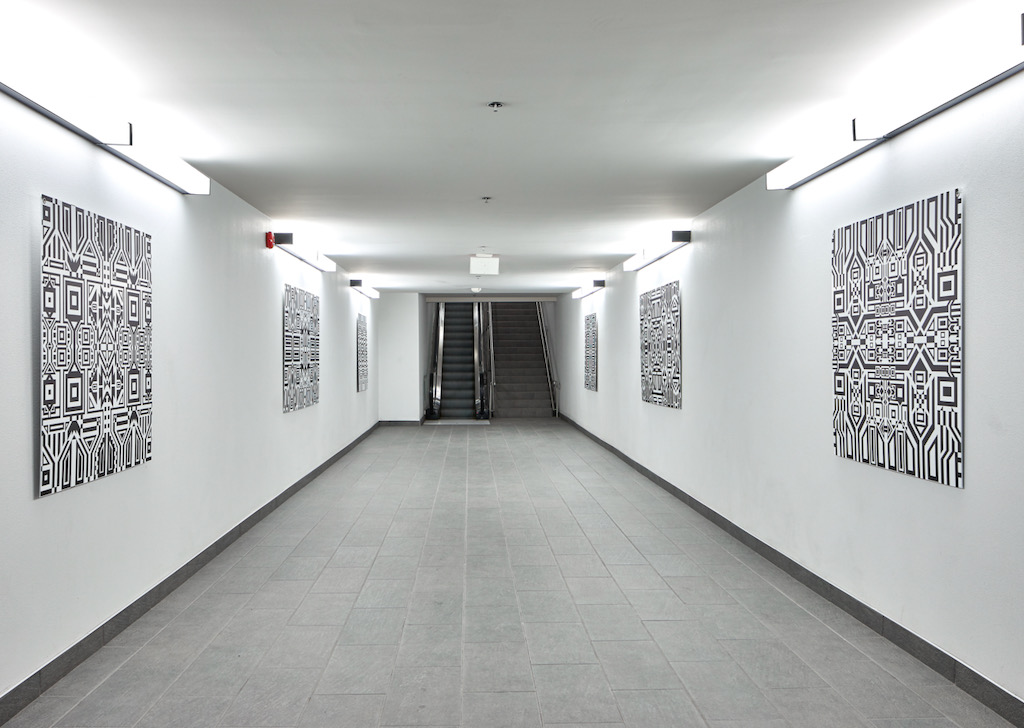
The technique of pyrography, where the image in burned into a native wood species such as white cedar, is a metaphor for the treatment First Nations have been given. Entirely machine embroidered, the original In the Name of Progress artwork calls back to the first automatic looms that were central to the Industrial Revolution and the advent of computer technology. The prints shown here utilize related techniques. The motifs point to how microchips are arranged in electric circuits, an allusion to technology’s dominance. The whole testifies to the disastrous consequences of colonization while at the same time acting as a reminder to be vigilant regarding our era’s path to progress.
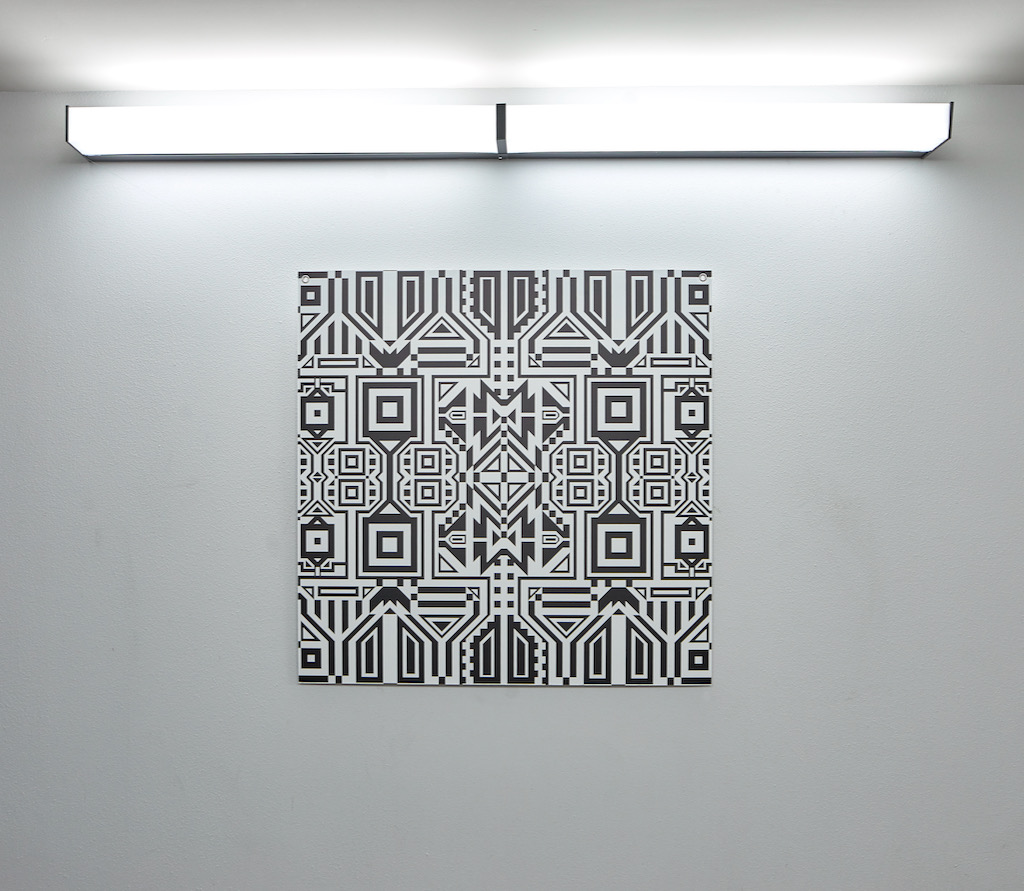
Caroline Monnet is a multidisciplinary artist from Gatineau who lives and works in Montreal. Having finished her studies at the University of Ottawa and the University of Grenada (Spain), she is pursuing a career in the visual arts and in film. Her pieces have been shown in Canada and internationally in Europe and the United States, notably during the 2019 Whitney Biennial and the Toronto Biennale as well as being collected and shown at the Musée d’art contemporain de Montréal and at the National Gallery of Canada. Caroline Monnet is represented by Galerie Division.
Dominique Sirois
Lives and works in Montréal
Consisting of sculptural arrangements of ceramics, castings, images and found objects, Dominique Sirois’ installations blend artisanal know-how with a critical approach to technology regarding its economic, esthetic, archeological and mineralogical dimensions.

This presentation involves investigating a prospective past of the future promised by technology, concerning most particularly the representations of faces, bodies and skins, which have today exploded on social media. Things are progressing as if these images could be compiled into some kind of map of a collective body, both seeker and sought. The artist is, moreover, interested in this emotional side of desire and adopts an approach analogous to behavioural economics, focusing on the place of the desiring gaze in relation to material possessions and wealth. In the spirit of memento mori or vanitas, the esthetics of the ruin are equally used here as a means of reflecting on the fleeting nature of objects and images. The way they change over time is likewise a recurring motif in Sirois’s work.
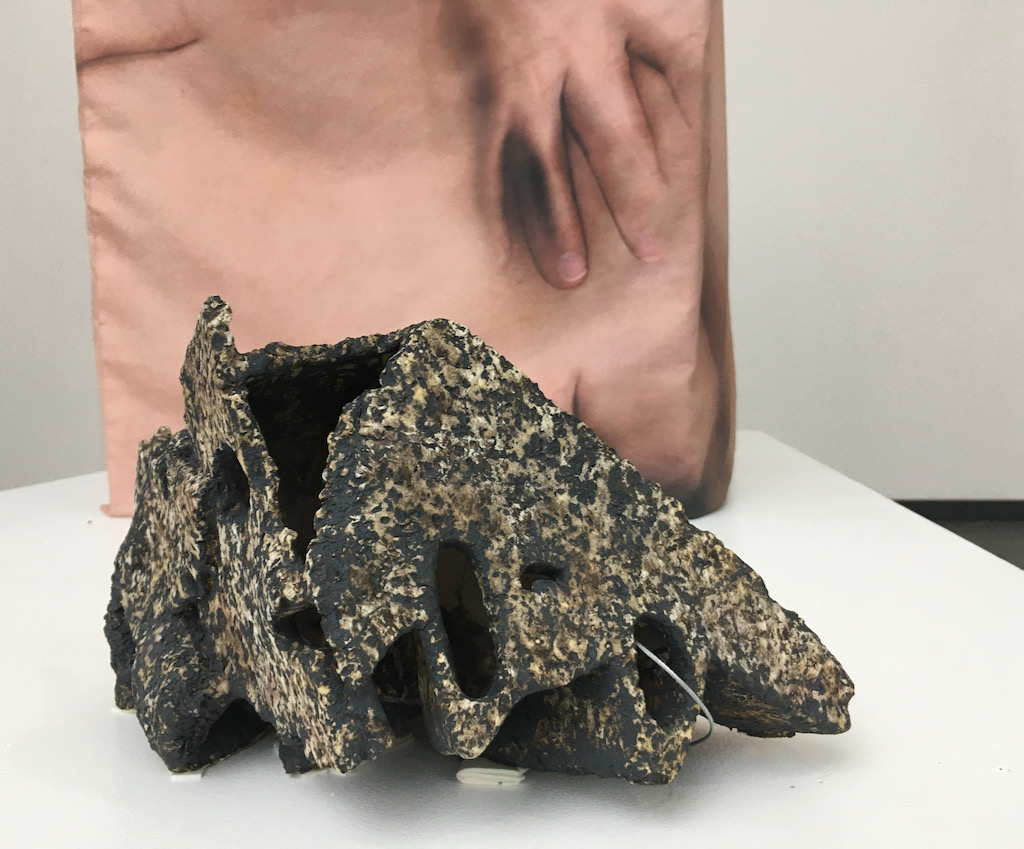
Dominique Sirois holds a Master of Fine Arts from the Université du Québec à Montréal, she is currently completing a doctorate. Her installation pieces have been shown in Canada at the Centre Clark, Galerie Division and Latitude 53. In partnership with Grégory Chatonsky, she has also exhibited at the Museum of Contemporary Art of Taipei, at the Centre d’art d’Enghien-les-Bains, at the Unicorn Center for Arts in Beijing, during the Mois de la Photo de Montréal, at iMAL, the Center for digital cultures and technology in Brussels, and more recently at Diagonale (Montreal). She has also participated in several residencies abroad, notably in Glasgow, Paris and Barcelona.
Bonnie Baxter
Lives and works in Val-David and Montréal
In this installation, Bonnie Baxter asks the viewer to project themselves into a utopian/dystopian future where a community of humanoid rats have supplanted human beings. Her presentation encourages us to overcome our fear and hatred of the rat, a feeling of dread that is deeply rooted in our subconscious, and therefore move beyond our preconceived notions and prejudices. Here, the physical proximity of rats to humans and our shared social behaviours make them a mirror image of our own existence.
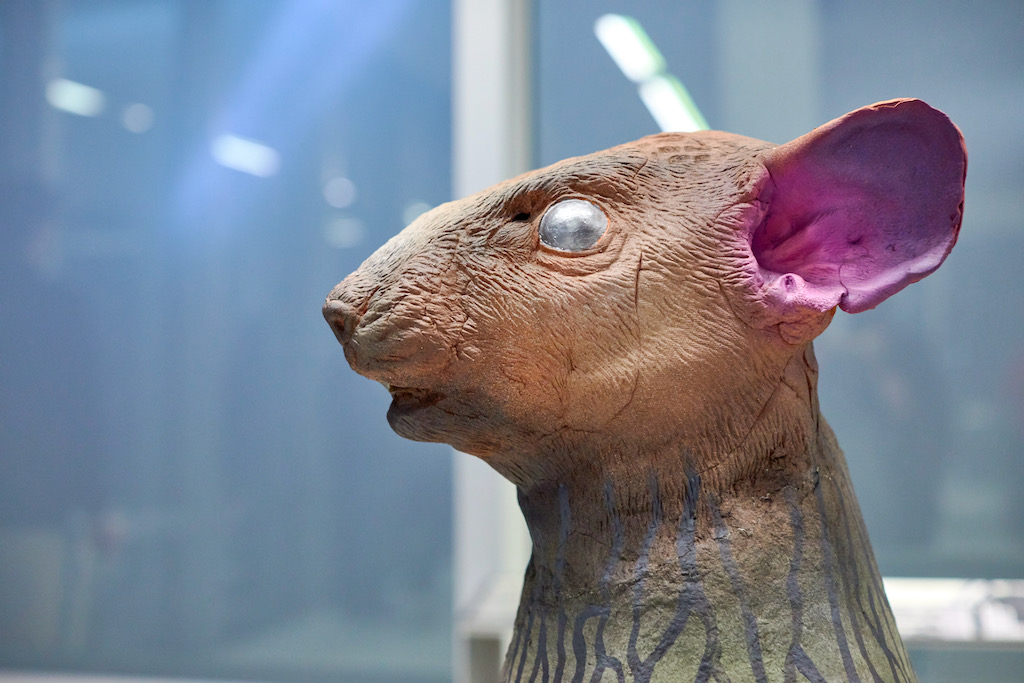
RatKind. Paradise Lost uses inter-species awareness to engage viewers’ consciousness of the environment, both social and ecological. It presents itself as an antidote to growing inequality, human rights issues and today’s environmental crisis. Within the theme of the emergence of a community that managed to survive a human-induced ecological disaster, Baxter’s friends and acquaintances perform as models and actors, and imagine a society based on empathy and respect for all living creatures and a feeling of goodwill towards nature. The majority of this series’ items were created in the artist’s spectacular gardens at her home in Val-David. The red poppies and goldfish images of the series Poppies recreate this bucolic place at the top of Place Ville-Marie.
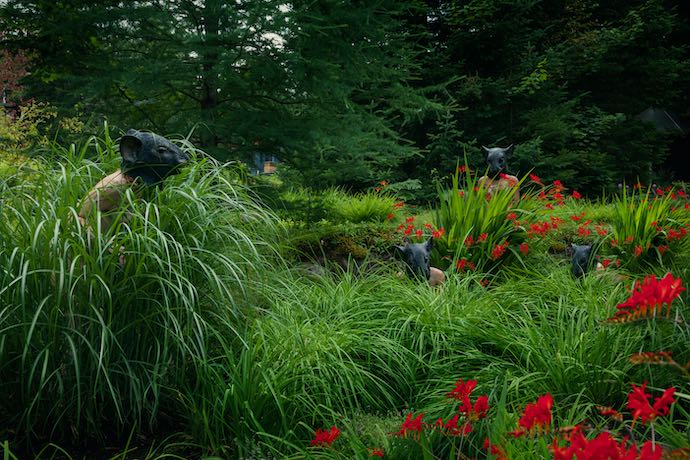
Bonnie Baxter’s recent work is instilled with the spirit of social ecology and realized through experimental print, installation, sculpture, and video. Her continuing series, RatKind, uses inter-species awareness to engage viewers’ consciousness of the environment, both social and ecological. Recent exhibitions include Spirit Matter at Clark Centre in 2020, RatKind: Paradise Lost at FOFA, Concordia University in 2019, as well as three major surveys of her work at the Musée d’art contemporain des Laurentides (MAC LAU) including the touring exhibition Rewind (2005-07) and Bonnie Baxter : Présent / Passé / Futur (2018-19).
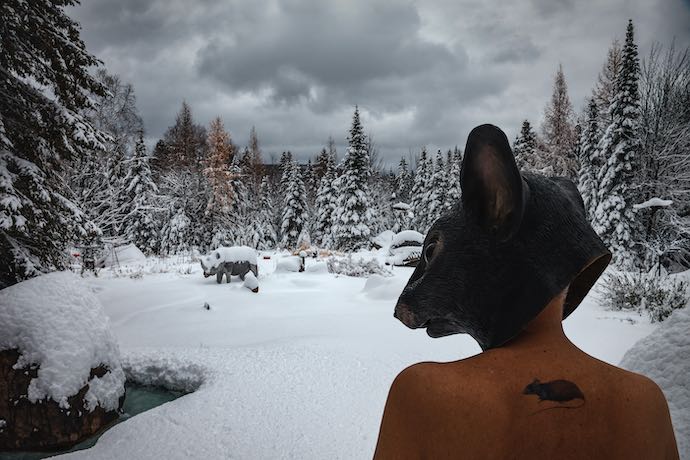
She was born in Texarkana, Texas and lives and works in Val-David, Québec where she founded the Atelier du Scarabée n 1982. Her work has been exhibited both nationally and internationally for more than 4 decades. In recent years her work has been awarded with the Prix Télé-Québec 2019 as part of the 11e BIECTR, the Prix les grand Soleils (a Lifetime achievement award) in 2018 and the Prix Charles Biddle in 2017. Bonnie Baxter is represented by Division Gallery.

